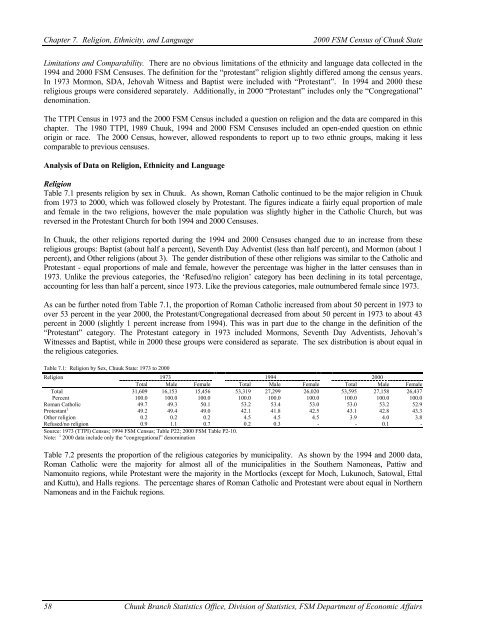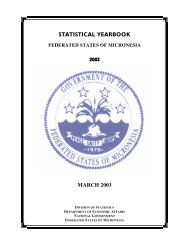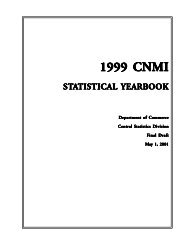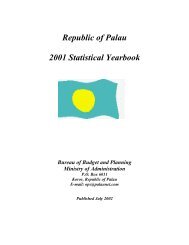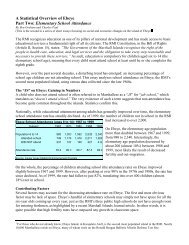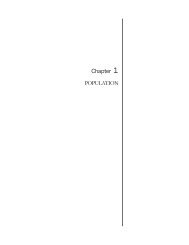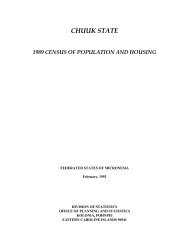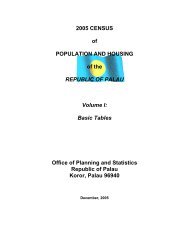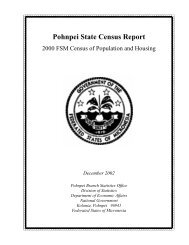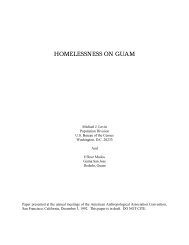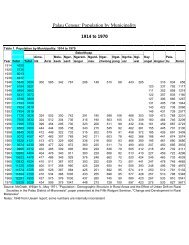Chapter 7. Religion, Ethnicity, and Language2000 FSM <strong>Census</strong> of <strong>Chuuk</strong> <strong>State</strong>Limitations and Comparability. There are no obvious limitations of the ethnicity and language data collected in the1994 and 2000 FSM <strong>Census</strong>es. The definition for the “protestant” religion slightly differed among the census years.In 1973 Mormon, SDA, Jehovah Witness and Baptist were included with “Protestant”. In 1994 and 2000 thesereligious groups were considered separately. Additionally, in 2000 “Protestant” includes only the “Congregational”denomination.The TTPI <strong>Census</strong> in 1973 and the 2000 FSM <strong>Census</strong> included a question on religion and the data are compared in thischapter. The 1980 TTPI, 1989 <strong>Chuuk</strong>, 1994 and 2000 FSM <strong>Census</strong>es included an open-ended question on ethnicorigin or race. The 2000 <strong>Census</strong>, however, allowed respondents to report up to two ethnic groups, making it lesscomparable to previous censuses.Analysis of Data on Religion, Ethnicity and LanguageReligionTable 7.1 presents religion by sex in <strong>Chuuk</strong>. As shown, Roman Catholic continued to be the major religion in <strong>Chuuk</strong>from 1973 to 2000, which was followed closely by Protestant. The figures indicate a fairly equal proportion of maleand female in the two religions, however the male population was slightly higher in the Catholic Church, but wasreversed in the Protestant Church for both 1994 and 2000 <strong>Census</strong>es.In <strong>Chuuk</strong>, the other religions reported during the 1994 and 2000 <strong>Census</strong>es changed due to an increase from thesereligious groups: Baptist (about half a percent), Seventh Day Adventist (less than half percent), and Mormon (about 1percent), and Other religions (about 3). The gender distribution of these other religions was similar to the Catholic andProtestant - equal proportions of male and female, however the percentage was higher in the latter censuses than in1973. Unlike the previous categories, the ‘Refused/no religion’ category has been declining in its total percentage,accounting for less than half a percent, since 1973. Like the previous categories, male outnumbered female since 1973.As can be further noted from Table 7.1, the proportion of Roman Catholic increased from about 50 percent in 1973 toover 53 percent in the year 2000, the Protestant/Congregational decreased from about 50 percent in 1973 to about 43percent in 2000 (slightly 1 percent increase from 1994). This was in part due to the change in the definition of the“Protestant” category. The Protestant category in 1973 included Mormons, Seventh Day Adventists, Jehovah’sWitnesses and Baptist, while in 2000 these groups were considered as separate. The sex distribution is about equal inthe religious categories.Table 7.1: Religion by Sex, <strong>Chuuk</strong> <strong>State</strong>: 1973 to 2000Religion 1973 1994 2000Total Male Female Total Male Female Total Male FemaleTotal 31,609 16,153 15,456 53,319 27,299 26,020 53,595 27,158 26,437Percent 100.0 100.0 100.0 100.0 100.0 100.0 100.0 100.0 100.0Roman Catholic 49.7 49.3 50.153.2 53.4 53.0 53.0 53.2 52.9Protestant 1 49.2 49.4 49.042.1 41.8 42.5 43.1 42.8 43.3Other religion 0.2 0.2 0.24.5 4.5 4.53.9 4.0 3.8Refused/no religion 0.9 1.1 0.7 0.2 0.3- - 0.1 -Source: 1973 (TTPI) <strong>Census</strong>; 1994 FSM <strong>Census</strong>; Table P22; 2000 FSM Table P2-10.Note: 1 2000 data include only the “congregational” denominationTable 7.2 presents the proportion of the religious categories by municipality. As shown by the 1994 and 2000 data,Roman Catholic were the majority for almost all of the municipalities in the Southern Namoneas, Pattiw andNamonuito regions, while Protestant were the majority in the Mortlocks (except for Moch, Lukunoch, Satowal, Ettaland Kuttu), and Halls regions. The percentage shares of Roman Catholic and Protestant were about equal in NorthernNamoneas and in the Faichuk regions.58 <strong>Chuuk</strong> Branch Statistics Office, Division of Statistics, FSM Department of Economic Affairs
2000 FSM <strong>Census</strong> of <strong>Chuuk</strong> <strong>State</strong>Chapter 7. Religion, Ethnicity, and LanguageTable 7.2: Religion by Municipality, <strong>Chuuk</strong> <strong>State</strong>: 1994 and 20001994 <strong>Census</strong> 2000 <strong>Census</strong>Roman Con- Other Refuse/ Roman Con- Refuse/Per- Cath- grega- Protes- Bap- Mor- Other no Per- Cath- grega- Bap- Mor- Other noMunicipality Total cent olic tional tant tist SDA mon relig. religion Total cent olic tional tist SDA mon relig. religionTotal 53,319 100.0 53.2 26.7 15.4 0.6 0.3 0.8 2.9 0.2 53,595 100.0 53.0 43.1 0.4 0.3 0.7 2.5 -Lagoon 41,662 100.0 52.2 24.0 18.3 0.7 0.3 1.0 3.3 0.2 40,465 100.0 51.5 44.2 0.5 0.4 0.9 2.6 0.1N. Namoneas 17,093 100.0 46.9 33.5 12.5 1.0 0.7 1.4 3.6 0.5 14,722 100.0 45.8 48.9 0.9 0.5 1.3 2.5 0.1Weno 16,121 100.0 46.0 33.9 12.5 1.0 0.7 1.4 3.8 0.5 13,802 100.0 43.9 50.6 0.8 0.5 1.4 2.6 0.1Piis-Paneu 490 100.0 94.3 1.0 4.5 0.2 - - - - 523 100.0 100.0 - - - - - -Fono 482 100.0 26.6 52.9 20.3 - - - 0.2 - 397 100.0 39.0 52.1 5.8 - - 2.8 0.3S. Namoneas 11,898 100.0 63.1 16.6 15.1 0.7 - 0.6 3.7 - 11,694 100.0 63.6 34.4 0.4 0.1 0.8 0.6 …Tonoas/Ette 3,949 100.0 41.3 29.0 26.8 0.3 - 0.3 2.3 0.1 3,910 100.0 42.9 54.1 0.1 … 1.0 1.9 0.1Fefen 4,042 100.0 68.2 6.7 15.7 1.9 0.1 - 7.4 - 4,062 100.0 68.3 30.6 0.9 0.2 … - …Siis 476 100.0 99.4 0.4 - - - - 0.2 - 490 100.0 99.8 - - - - 0.2 -Uman 3,056 100.0 74.4 18.2 3.5 - - 2.2 1.6 - 2,847 100.0 74.7 23.1 … … 2.0 - -Parem 375 100.0 98.7 1.1 - 0.3 - - - - 385 100.0 96.9 3.1 - - - - -Faichuk 12,671 100.0 49.2 18.0 29.1 0.2 - 0.8 2.5 0.1 14,049 100.0 47.2 47.3 0.1 0.5 0.5 4.4 …Eot 361 100.0 17.5 2.8 70.9 - - - 8.9 - 382 100.0 18.3 81.2 0.3 - 0.3 - -Udot 1,598 100.0 64.5 9.3 21.9 - 0.1 0.7 3.3 0.2 1,774 100.0 61.7 35.2 - - 0.7 2.4 -Romanum 711 100.0 80.5 3.8 9.4 - 0.3 4.6 1.4 - 1,011 100.0 81.7 14.4 - - 3.9 - -Fanapanges 606 100.0 99.3 0.5 - - - - 0.2 - 681 100.0 100.0 - - - - - -Wonei 1,434 100.0 77.2 1.9 19.1 1.4 - - 0.4 - 1,271 100.0 80.2 19.6 - 0.2 - - -Paata 1,825 100.0 29.1 17.3 50.4 - 0.1 1.9 1.0 - 1,950 100.0 26.7 72.0 0.1 1.1 0.1 - -Tol 4,816 100.0 27.4 32.0 35.9 0.2 - 0.4 4.0 - 5,129 100.0 22.8 65.9 0.1 - 0.2 10.9 …Polle 1,320 100.0 76.7 16.0 6.7 - - 0.1 0.5 - 1,851 100.0 67.9 29.0 - 2.6 - 0.5 -Outer Islands 11,657 100.0 56.6 36.6 5.1 - 0.1 0.1 1.5 - 13,130 100.0 57.9 39.6 0.1 0.2 … 2.2 …Mortlocks 6,471 100.0 46.1 45.3 6.7 - - 0.2 1.6 - 6,911 100.0 45.9 52.0 0.1 - … 2.0 -Nama 881 100.0 1.4 45.6 41.0 - 0.2 1.0 10.8 - 995 100.0 0.3 88.5 - - 0.1 11.1 -Losap 455 100.0 0.2 98.2 - - - - 1.5 - 448 100.0 - 100.0 - - - - -Piis-Emwar 448 100.0 - 99.8 - - - 0.2 - - 427 100.0 0.2 99.5 - - - 0.2 -Namoluk 402 100.0 47.3 52.7 - - - - - - 407 100.0 39.6 60.4 - - - - -Ettal 356 100.0 79.2 20.8 - - - - - - 267 100.0 82.0 18.0 - - - - -Lekinioch 802 100.0 91.1 8.9 - - - - - - 927 100.0 92.4 7.3 - - 0.1 0.1 -Oneop 550 100.0 2.9 97.1 - - - - - - 505 100.0 0.8 98.8 0.2 - 0.2 - -Satowan 823 100.0 62.8 36.8 - 0.1 - 0.1 0.1 - 955 100.0 58.1 41.2 0.3 - - 0.4 -Kuttu 633 100.0 68.6 20.5 10.3 - - 0.6 - - 873 100.0 63.5 34.8 - - - 1.7 -Moch 837 100.0 94.5 4.4 1.0 - - - - 0.1 854 100.0 95.9 4.0 - - - 0.1 -Ta 284 100.0 4.2 95.8 - - - - - - 253 100.0 0.4 98.0 - - - 1.6 -Pattiw 2,171 100.0 88.1 3.3 5.0 - 0.3 - 3.3 - 2,736 100.0 86.5 13.5 - - … - …Houk 494 100.0 96.2 - 0.2 - - - 3.6 - 451 100.0 99.8 - - - - - 0.2Polowat 688 100.0 65.4 10.5 15.6 0.1 0.9 - 7.6 - 1,015 100.0 63.6 36.3 - - 0.1 - -Pollap 710 100.0 99.9 - - - - - 0.1 - 905 100.0 100.0 - - - - - -Tamatam 279 100.0 100.0 - - - - - - - 365 100.0 100.0 - - - - - -Namonuito 1,001 100.0 99.3 0.2 0.2 0.3 - - - - 1,341 100.0 99.5 0.4 - - - 0.1 -Makur 151 100.0 99.3 - 0.7 - - - - - 156 100.0 100.0 - - - - - -Onoun 436 100.0 99.3 - - 0.7 - - - - 580 100.0 99.3 0.3 - - - 0.3 -Onou 118 100.0 98.3 1.7 - - - - - - 182 100.0 98.4 1.6 - - - - -Unanu 131 100.0 100.0 - - - - - - - 178 100.0 100.0 - - - - - -Piherarh 165 100.0 99.4 - 0.6 - - - - - 245 100.0 100.0 - - - - - -Halls 2,014 100.0 35.1 62.6 2.3 - - - - - 2,142 100.0 33.9 57.5 0.3 1.0 0.1 7.2 -Nomwin 746 100.0 6.3 93.7 - - - - - - 711 100.0 4.5 94.1 0.3 - 0.1 1.0 -Fananu 320 100.0 25.9 74.1 - - - - - - 355 100.0 33.2 40.0 - - - 26.8 -Ruo 397 100.0 34.5 65.2 0.3 - - - - - 469 100.0 43.1 45.8 - 4.5 - 6.6 -Murillo 551 100.0 79.9 12.0 8.2 - - - - - 607 100.0 61.8 33.9 0.7 - 0.2 3.5 -Source: 1994 FSM <strong>Census</strong>, Table P22; 2000 FSM <strong>Census</strong>, Table P2-10.Table 7.3 shows religion by age group for census years, 1994 and 2000. Over this 6-year period, the proportion ofProtestants and Roman Catholics in age groups 0-14, 15-34, and 35-64 did not change. In contrast, the proportion ofindividuals aged 65 and over were changed; increased with Roman Catholic and decreased with Protestant between1994 and 2000.Table 7.3: Religion by Age Group, <strong>Chuuk</strong> <strong>State</strong>: 1994 and 20001994 2000Religion Total 0-14 15-34 35-64 65+ Total 0-14 15-34 35-64 65+Total 53,319 24,251 17,739 9,455 1,874 53,595 22,008 19,348 10,294 1,945Percent 100.0 100.0 100.0 100.0 100.0 100.0 100.0 100.0 100.0 100.0Roman Catholic 53.2 54.2 53.2 51.6 48.4 53.0 54.1 52.7 51.8 51.1Protestant 1 42.1 41.4 42.2 42.8 46.9 43.1 42.0 43.6 44.1 44.7Baptist 0.6 0.6 0.5 0.6 0.2 0.4 0.4 0.3 0.4 0.2Seventh Day Adventist (SDA) 0.3 0.3 0.2 0.3 0.1 0.3 0.3 0.3 0.3 0.5Latter Day Saints (Mormon) 0.8 0.8 0.8 0.8 0.9 0.7 0.7 0.6 0.7 0.8Other religion 2.9 2.7 3.0 3.3 3.3 2.5 2.5 2.5 2.6 2.8Refused/no religion 0.2 - 0.1 0.7 0.2 - - 0.1 - 0.1Source: 1994 FSM <strong>Census</strong>, Table P39; 2000 FSM <strong>Census</strong>, Table P3-8.Note: 1 2000 data include only the “congregational” denomination<strong>Chuuk</strong> Branch Statistics Office, Division of Statistics, FSM Department of Economic Affairs 59


